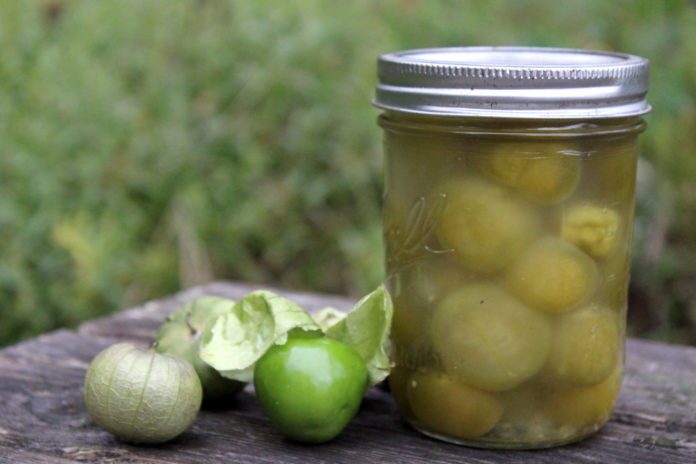Canning tomatillos at home is a quick and easy way to preserve whole tomatillos for use all year long. Most tomatillo recipes start by simmering the tomatillos, and canning them ahead of time will save effort and allow you to get dinner on the table faster on a busy weeknight.
Every year we grow tomatillos in our garden, and we often harvest 40 to 50 pounds of fruit from just a few plants. They’re exceptionally productive, without any care or tending. Just one or two forgotten fruits and you’ll have tomatillo volunteers for years to come.
It’s been two years since I actually planted tomatillos in my garden, but the volunteers keep coming up. The seeds will sprout up and produce in sections of lawn, or in the compacted area right next to the gravel driveway. There’s really no stopping them.


Most years, I preserve tomatillos in a home-canned green sauce for enchiladas and marinades. My recipe is adapted from a ball canning recipe and has a lot of added lime juice. The lime juice adds great flavor to the sauce, but I also assumed that the additional acidity was required to safely water bath can tomatillos.
I recently learned that tomatillos can be water bath canned without added acidity. Canning tomatillos whole is a lot more versatile than a pre-seasoned green sauce, and they’re perfect for winter soups.
Since tomatillos need to be hotly packed, the fruits must be cooked before they go into the canning jars. A quick simmer in boiling water is sufficient, but you can also roast the tomatillos in the oven for more flavor. Many recipes call for roasted tomatillos anyway, and that extra dry heat before canning will add a smokey, caramelized flavor to the canned tomatillos.


The fruits lose a substantial amount of their volume in the initial pre-cook before hot packing, and a full pound of tomatillos can fit into a single pint mason jar or two pounds per quart jar.
Since the fruits have a tough skin, it’s helpful to pierce each one with a needle or fork before pre-cooking. This will keep them from popping, and result in cleaner jars of canned tomatillos with more intact whole fruits.
The tomatillos don’t need to be chopped or peeled of their inner skin before canning, just remove the papery outer husk, and parboil or roast before packing them into canning jars. Though studies have shown that tomatillos are generally more acidic than tomatoes, and well below the safe cutoff for canning without added acid, the National Center for Home Food Preservation still calls for adding lemon juice to the canning liquid at a rate of one tablespoon per pint.
While it may not be strictly necessary to add acid, the lemon juice adds extra flavor to the canned tomatillos and better safe than sorry. Either way, acid or not, the tomatillos are canned in a water bath canner with 1/2 inch headspace for 40 minutes for pints and 45 minutes for quarts.


Canning Whole Tomatillos
Simple canned whole tomatillos are versatile in recipes and can be quickly put up using a water bath canner.
- 9 lbs Tomatillos (fresh)
- 9 tbsp lemon juice
- boiling water
- Remove the papery outer husks from the tomatillos and pierce each one with a needle or fork (optional).
- Simmer tomatillos in boiling water for about 5 minutes, until they lose their bright green color.
- Add one tablespoon of lemon juice to each pint canning jar (or 2 tbsp for quarts). Pack whole tomatillos into canning jars and cover with boiling water, leaving 1/2 inch headspace.
- Seal with 2 part lids and process in a water bath canner for 40 minutes (pints) or 45 minutes (quarts) adjusting for altitude.
- If you prefer, tomatillos can be pressure canned at 10 pounds pressure for 10 minutes instead, but pressure canning is not strictly required as they are a high acid food.
The recipe makes 9 pints.





















